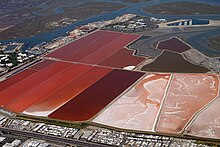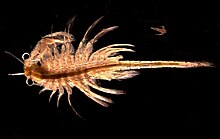Brine shrimp
| Brine shrimp | |
|---|---|

| |
| Artemia salina mating pair – female left, male right | |
| Scientific classification | |
| Domain: | Eukaryota |
| Kingdom: | Animalia |
| Phylum: | Arthropoda |
| Class: | Branchiopoda |
| Subclass: | Sarsostraca |
| Order: | Anostraca |
| Suborder: | Artemiina |
| Family: | Artemiidae Grochowski, 1895 |
| Genus: | Artemia Leach, 1819 |
| Species[1] | |
| |
Artemia is a genus of aquatic crustaceans also known as brine shrimp or sea monkeys. It is the only genus in the family Artemiidae. The first historical record of the existence of Artemia dates back to the first half of the 10th century AD from Lake Urmia, Iran, with an example called by an Iranian geographer an "aquatic dog",[2] although the first unambiguous record is the report and drawings made by Schlösser in 1757 of animals from Lymington, England.[3] Artemia populations are found worldwide, typically in inland saltwater lakes, but occasionally in oceans. Artemia are able to avoid cohabiting with most types of predators, such as fish, by their ability to live in waters of very high salinity (up to 25%).[4]
The ability of the Artemia to produce dormant eggs, known as
Description
The brine shrimp Artemia comprises a group of seven to nine species very likely to have diverged from an ancestral form living in the
.The Laboratory of Aquaculture & Artemia Reference Center at Ghent University possesses the largest known Artemia cyst collection, a cyst bank containing over 1,700 Artemia population samples collected from different locations around the world.[7]
Artemia is a typical primitive arthropod with a segmented body to which is attached broad leaf-like appendages. The body usually consists of 19 segments, the first 11 of which have pairs of appendages, the next two which are often fused together carry the reproductive organs, and the last segments lead to the tail.[8] The total length is usually about 8–10 millimetres (0.31–0.39 in) for the adult male and 10–12 mm (0.39–0.47 in) for the female, but the width of both sexes, including the legs, is about 4 mm (0.16 in).
The body of Artemia is divided into head, thorax, and abdomen. The entire body is covered with a thin, flexible exoskeleton of chitin to which muscles are attached internally and which is shed periodically.[9] In female Artemia, a moult precedes every ovulation.
For brine shrimp, many functions, including swimming, digestion and reproduction are not controlled through the brain; instead, local nervous system
Ecology and behavior
Brine shrimp can tolerate any levels of

Reproduction
Males differ from females by having the second antennae markedly enlarged, and modified into clasping organs used in mating.[12] Adult female brine shrimp ovulate approximately every 140 hours. In favourable conditions, the female brine shrimp can produce eggs that almost immediately hatch.[citation needed] While in extreme conditions, such as low oxygen level or salinity above 150‰, female brine shrimp produce eggs with a chorion coating which has a brown colour. These eggs, also known as cysts, are metabolically inactive and can remain in total stasis for two years while in dry oxygen-free conditions, even at temperatures below freezing. This characteristic is called cryptobiosis, meaning "hidden life". While in cryptobiosis, brine shrimp eggs can survive temperatures of liquid air (−190 °C or −310 °F) and a small percentage can survive above boiling temperature (105 °C or 221 °F) for up to two hours.[11] Once placed in briny (salt) water, the eggs hatch within a few hours. The
Parthenogenesis

Parthenogenesis is a natural form of reproduction in which growth and development of embryos occur without fertilisation. Thelytoky is a particular form of parthenogenesis in which the development of a female individual occurs from an unfertilised egg. Automixis is a form of thelytoky, but there are different kinds of automixis. The kind of automixis relevant here is one in which two haploid products from the same meiosis combine to form a diploid zygote.
Diploid Artemia parthenogenetica reproduce by automictic parthenogenesis with central fusion (see diagram) and low but nonzero recombination.[13] Central fusion of two of the haploid products of meiosis (see diagram) tends to maintain heterozygosity in transmission of the genome from mother to offspring, and to minimise inbreeding depression. Low crossover recombination during meiosis likely restrains the transition from heterozygosity to homozygosity over successive generations.
Diet
In their first stage of development, Artemia do not feed but consume their own energy reserves stored in the cyst.
Genetics, genomics and transcriptomics
Artemia comprises sexually reproducing,
Aquaculture

Fish farm owners search for a cost-effective, easy to use, and available food that is preferred by the fish. From cysts, brine shrimp nauplii can readily be used to feed fish and crustacean larvae just after a one-day incubation. Instar I (the nauplii that just hatched and with large yolk reserves in their body) and instar II nauplii (the nauplii after first moult and with functional digestive tracts) are more widely used in aquaculture, because they are easy for operation, rich in nutrients, and small, which makes them suitable for feeding fish and crustacean larvae live or after drying.
Toxicity test
Artemia found favor as a
In pollution research Artemia, the brine shrimp, has had extensive use as a test organism and in some circumstances is an acceptable alternative to the
Conservation

Overall, brine shrimp are abundant, but some populations and localized species do face threats, especially from habitat loss to introduced species. For example, A. franciscana of the Americas has been widely introduced to places outside its native range and is often able to outcompete local species, such as A. salina in the Mediterranean region.[27][28]
Among the highly localized species are
Space experiment
Scientists have taken the eggs of brine shrimp to
On Apollo 16 and Apollo 17, the cysts traveled to the Moon and back. Cosmic rays that passed through an egg would be detected on the photographic film in its container. Some eggs were kept on Earth as experimental controls as part of the tests. Also, as the take-off in a spacecraft involves a lot of shaking and acceleration, one control group of egg cysts was accelerated to seven times the force of gravity and vibrated mechanically from side to side for several minutes so that they could experience the same violence of a rocket take-off.[32] About 400 eggs were in each experimental group. All the egg cysts from the experiment were then placed in salt water to hatch under optimum conditions. The results showed A. salina eggs are highly sensitive to cosmic radiation; 90% of the embryos induced to develop from hit eggs died at different developmental stages.[33]
References
- ^ Alireza Asem (2023). "Phylogenetic analysis of problematic Asian species of Artemia Leach, 1819 (Crustacea, Anostraca), with the descriptions of two new species". Journal of Crustacean Biology. 83: 1–25.
- ^ Alireza Asem; Amin Eimanifar (2016). "Updating historical record on brine shrimp Artemia (Crustacea: Anostraca) from Urmia Lake (Iran) in the first half of the 10th century AD" (PDF). International Journal of Aquatic Science. 7: 1–5. Archived from the original (PDF) on 2016-04-01. Retrieved 2016-11-24.
- ^ Alireza Asem (2008). "Historical record on brine shrimp Artemia more than one thousand years ago from Urmia Lake, Iran" (PDF). Journal of Biological Research-Thessaloniki. 9: 113–114. Archived from the original (PDF) on 2016-12-01. Retrieved 2013-05-17.
- ^ OCLC 222006176.
- ^ "Introduction, biology and ecology of Artemia". Retrieved 15 October 2022.
- OCLC 17978639.
- ISBN 978-90-5989-717-5.
- ^ OL 19205202M.
- ^ ISBN 978-1-4020-0746-0.
- ^ ISBN 978-3-540-26011-0.
- ^ a b Whitey Hitchcock. "Brine shrimp". Clinton High School Science. Archived from the original on September 3, 2010. Retrieved March 13, 2010.
- JSTOR 3225702.
- PMID 26356354.
- .
- ^ Kai Schumann (August 10, 1997). "Artemia (Brine Shrimp) FAQ 1.1". Portland State University. Archived from the original on August 14, 2007. Retrieved March 13, 2010.
- PMID 21145977.
- PMID 23469207.
- S2CID 233663524.
- S2CID 92842322.
- S2CID 234621039. Retrieved 2021-09-02.
- S2CID 201700530.
- S2CID 51624497.
- PMID 33606769.
- ^ PMID 34465293.
- ^ Micharl Dockey & Stephen Tonkins. "Brine shrimp ecology" (PDF). British Ecological Society. Archived from the original (PDF) on 2009-07-08.
- S2CID 88834451.
- S2CID 23565318.
- ISSN 1809-127X.
- ^ "Lake Urumia's Artemia Face Extinction". Financial Tribune. 28 December 2014. Retrieved 29 January 2018.
- S2CID 25998873. Archived from the original(PDF) on 2020-02-10.
- ^ "Endangered and Threatened Wildlife and Plants; 12-Month Finding for a Petition to List the Mono Lake Brine Shrimp as Endangered". Federal Register. 60 (173): 46571–46572. 1995.[permanent dead link]
- ^ H. Planel; Y. Gaubin; R. Kaiser; B. Pianezzi (1980). "The effects of cosmic rays on Artemia egg cysts". Laboratoire Médicale. Report for National Aeronautics and Space Administration.
- PMID 11887916.
External links
 Media related to Artemia at Wikimedia Commons
Media related to Artemia at Wikimedia Commons- "Genus Artemia". Systema Naturae 2000. The Taxonomicon. Archived from the original on March 13, 2010. Retrieved March 13, 2010.
- Richard Fox (February 13, 2004). "Artemia Laboratory Exercise – Artemia franciscana". Archived from the original on April 23, 2006. Retrieved March 13, 2010.
- "Brine Shrimp and Ecology of Great Salt Lake". United States Geological Survey. May 15, 2009. Retrieved March 13, 2010.

